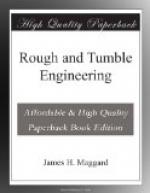If, however, the load fluctuates and should the load be light for any considerable part of the day, they will waste the fuel instead of saving it over the simple engine.
No engine can be subjected to more variation of loads than the traction engine, and as the above are facts the reader can draw his own conclusions.
FRICTION CLUTCH
The friction clutch is now used almost exclusively for engaging the engine with the propelling gearing of the traction drivers, and it will most likely give you more trouble than any one thing on your engine, from the fact that to be satisfactory they require a nicety of adjustment, that is very difficult to attain, a half turn of the expansion bolt one way or the other may make your clutch work very nicely, or very unsatisfactory, and you can only learn this by carefully adjusting of friction shoes, until you learn just how much clearance they will stand when lever is out, in order to hold sufficient when lever is thrown in. If your clutch fails to hold, or sticks, it is not the fault of the clutch, it is not adjusted properly. And you may have it correct today and tomorrow it will need readjustment, caused by the wear in the shoes; you will have to learn the clutch by patience and experience.
But I want to say to you that the friction clutch is a source of abuse to many a good engineer, because the engineer uses no judgment in its use.
A certain writer on engineering makes use of the following, and gives me credit: “Sometimes you may come to an obstacle in the road, over which your engine refuses to go, you may perhaps get over it in this way, throw the clutch-lever so as to disconnect the road wheels, let the engine get up to full speed and then throw the clutch level back so as to connect the road wheels.” Now I don’t thank any one for giving me credit for saying any such thing. That kind of thing is the hight of abuse of an engine.
I am aware that when the friction clutch first came into use, their representatives made a great talk on that sort of thing to the green buyer. But the good engineer knows better than to treat his engine that way.
Never attempt to pull your loads over a steep hill without being certain that your clutch is in good shape, and if you have any doubts about it put in the tight gear pin. Most all engines have both the friction and the tight gear pin. The pin is much the safer in a hilly country, and if you have learned the secret of the throttle you can handle just as big load with the pin as with the clutch, and will never tear your gearing off or lose the stud bolts in boiler.
The following may assist you in determining or arriving at some idea of the amount of power you are supplying with your engine:
For instance, a I inch belt of the standard grade with the proper tention, neither too tight or too loose, running at a. maximum spead of 800 ft. a minute will transmit one horse power, running 1600 ft. 2 horse power and 2400 ft. 3 horse power. A 2 inch belt, at the same speed, twice the power.




